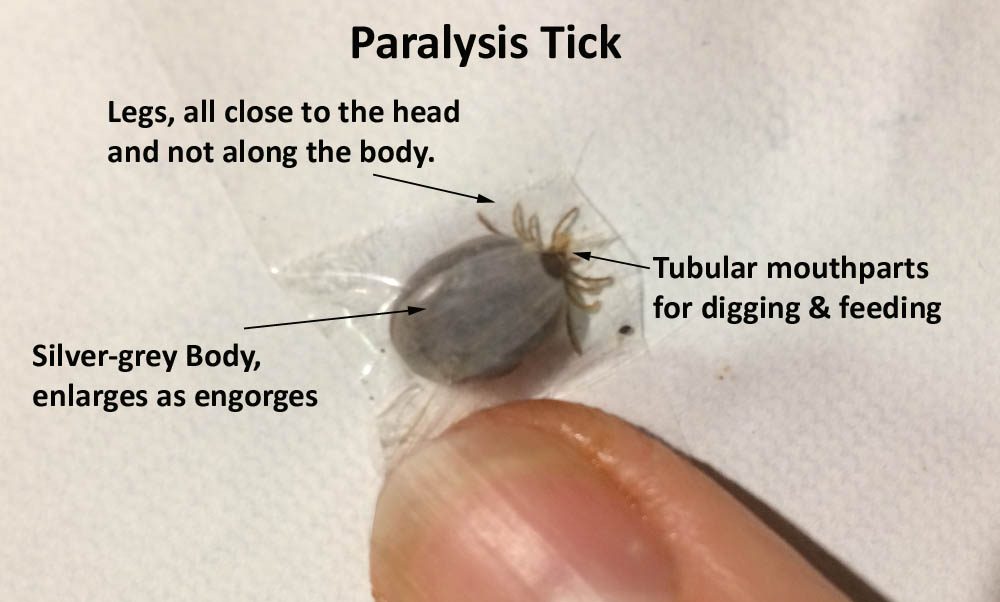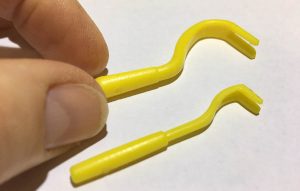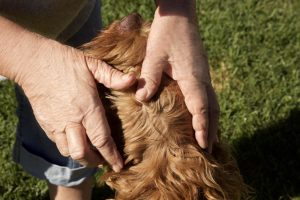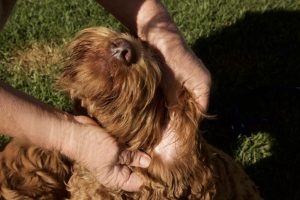
Since our recent near-death experience with our precious Reddy, we thought we should follow up with a blog about paralysis ticks and keeping your pet safe. Typically, ticks are considered to be Spring/Summer afflictions, but rain and warmer weather brings ticks out earlier; and though areas are considered ‘tick prone’ or ‘tick free’, birds don’t read our guidelines and can carry and drop ticks freely! Reference Reddy and our recent vet emergency in July in our ‘tick free’ area!
We lived for years in Maleny which is a high tick infested area, and have witnessed our own dogs and cats, horses and cows, and even koala and lorikeet tick paralysis. We now live on what is considered a low-tick property, but our experience has prompted us to do more research about tick protection and prevention, and to be more vigilant.
How Do Dogs Get Ticks?
Native animals are hosts for the paralysis tick, and are mostly immune to paralysis. Long grasses help distribution – the ticks cling to the top of the grasses and wait for an animal to brush by and carry them away. So bushland and the Coast hinterland are especially tick-prone. It is important for you to consider not only your home environment, but where your dog is walked and exercised.
Tick Paralysis & Signs
Ticks transfer onto mammals, attach and while feeding on their blood and engorging (filling their body and getting larger), secrete a neuro-toxin, poison, into the host’s bloodstream. The toxin disturbs the nervous system and muscular system, causing paralysis. You may notice your dog’s bark is different, or they regurgitate some food or drink; but the most common first sign is wobbly walking as the back legs become involved! When this is noticed, it is a rapid downhill slide to complete inability to sit or walk, and breathing difficulties.
Tick ID & Removal
When wobbly walking is noticed and you find a tick, you must remove it immediately and get your dog to the vet for tick serum emergency care. Don’t delay. Remove the tick by sliding your fingernail under it, grip firmly and twist as you pull strongly; or use a tick detacher (easily and cheaply purchased online). Don’t stress about the ‘right way’ to get it off, just remember not to ‘squeeze’ the tick; follow the above instructions and get it off!

Searching For a Tick
Because ticks commonly get onto the dog as it brushes against grasses, ticks are usually, but not always, on the front - chest, collar, neck and head, around eyes, inside ears. They can be anywhere on the dog, including between the paw pads and just inside the anus.
Start at the front of the dog, move methodically over every part.
- Separate the coat layers systematically and move your thumb over the skin between the coat fibres, feeling for any bumps on the surface. A tick may be small or large depending on part of the lifecycle and how long it has been feeding.
- Take extra care around the eyes, in the ears and muzzle (sometimes just inside the lip), between the paw pads, under the tail and around the anus.


Tick Treatment
If a tick is found, remove it and head for your vet clinic. If you have a natural tick remedy for tick bite, use as per instructions as you head to your vet. We used this for Reddy, and she did have a really rapid smoother recovery than we have witnessed before! You can ask about natural tick remedy at The Natural Vet on 5476 7674.
Your vet will give tick serum and want to observe your pet. Most healthy, younger animals recover well with good vet and home management over a few months; old animals or animals with pre-existing health issues may not recover so well.
Tick Paralysis Prevention
During our recent tick paralysis experience, I noticed a very slight change in Reddy’s enthusiasm and walking, and suspected a tick right away. If you are truly close and familiar with your dog’s nature and habits, you may be able to observe subtle changes sooner which will give you an important advantage in paralysis tick management.
Other important habits in tick season and are:
- Be aware! Watch your pet for signs.
- Keeping your pets coat short during tick season can help.
- Do a full body tick search every day.
- Exercise your pet away from bushland or long grass.
- Use a natural tick repellent or remedy to help keep ticks away, remember nothing is guaranteed!
The Natural Vets offer these, including a product called Tick Trickster. - Consider chemical tick prevention if you can’t be sure about risks and other prevention. This is a really difficult subject, as there are short and long-term risks associated with chemical tick and flea treatments. There is a really comprehensive discussion on this matter at The Natural Vets website, under How to Prevent Tick Paralysis and How Safe are Oral Tick Preventatives.
- Never get complacent!

If you would like to adopt a Ridgy Didge Australian Cobberdog, please read our Adopting a Puppy information, before you continue the adoption process. For more information, pm us on Facebook, or contact us at our website. Like and follow us on Facebook to keep up to date with ongoing puppy news and announcements.
